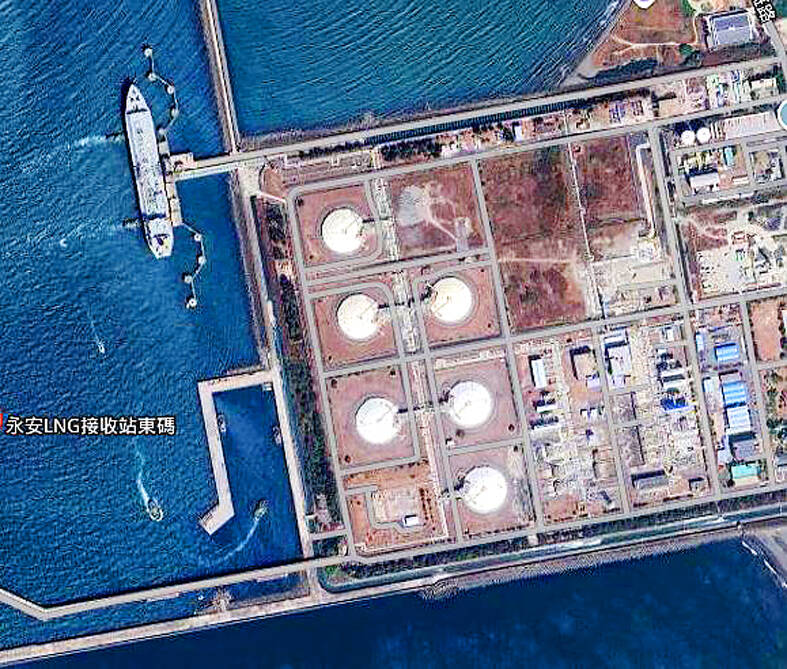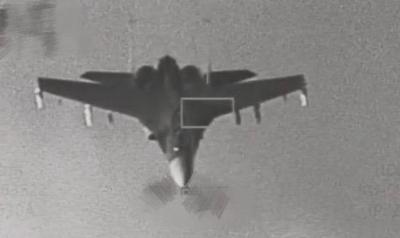A propaganda video released on Wednesday by the Chinese People’s Liberation Army (PLA) depicting missile strikes on liquefied natural gas (LNG) terminals highlights the growing military threat to Taiwan’s critical energy infrastructure, a defense analyst said yesterday.
The video, on official PLA social media, shows rocket artillery systems launching 16 missiles at a mock compound resembling the LNG storage facility in Kaohsiung’s Yongan District (永安).
Schematic propaganda images also posted on Wednesday showed six missiles imposed over locations corresponding to the nation’s coastal LNG terminal projects on a map of Taiwan proper.

Photo: Screen grab from Google Maps
The materials were published as the PLA began its “Strait Thunder 2025A” military exercises.
Chieh Chung (揭仲), a research fellow at the Association of Strategic Foresight, said the scenario aligns with PLA doctrine emphasizing neutralizing high-value targets with precision strikes, while aiming to limit broader destruction.
Destroying the nation’s LNG offloading terminals would allow China to cripple the nation’s energy system, while minimizing damage that occupation forces would need to repair, he said.
For the same reason, Taiwan should expect Chinese long-range strikes on critical power grid transformers and local government offices during the early stages of a ground invasion, as such targets would disrupt civil order and governance, he added.
The PLA’s recent videos underscore a major vulnerability — the lack of redundancy in Taiwan’s energy network, Chieh said.
Although Taiwan has made progress in building air raid shelters, it has not yet developed hardened logistics infrastructure to secure water, electricity and food supplies during wartime, he said.
To maintain basic services in the event of conflict, Taiwan might ultimately need to centralize its mostly privatized infrastructure sector, he added.
Meanwhile, Taiwanese experts have urged the government to bolster its ability to counter nontraditional security threats, as the China Coast Guard has taken on an increasingly prominent role in the latest round of military exercises surrounding Taiwan — part of Beijing’s escalating “gray zone” tactics.
The PLA’s Eastern Theater Command on Tuesday announced the launch of joint military drills around Taiwan. The following morning, it announced the “Strait Thunder 2025A” drills in parts of the Taiwan Strait. By Wednesday evening, it declared the conclusion of the two-day exercises.
Asked about the significance of the latest round of Chinese drills, Chen Wen-chia (陳文甲), senior consultant for the Taipei-based think tank Institute for National Policy Research, said the PLA had mobilized all major branches — the army, navy, air force and rocket force — to conduct coordinated exercises aimed at testing their joint operational capabilities targeting Taiwan.
During the two-day drills, PLA forces also conducted simulated precision strikes on key Taiwanese infrastructure and practiced blockading major ports, Chen said, adding that the exercises highlighted the increasing sophistication of China’s military preparations for a potential conflict with Taiwan.
Notably, the China Coast Guard played a significantly larger role in this round of drills, conducting simulated law enforcement inspections in the Taiwan Strait — a move that underscores Beijing’s efforts to blur the line between military and civilian operations, Chen said.
Su Tzu-yun (蘇紫雲), a division director at the Taiwan military-funded Institute for National Defense and Security Research, said that unlike the PLA’s “Joint Sword” exercises last year, the latest drills saw China’s coast guard simulating the inspection, repulsion and interception of civilian vessels in the Taiwan Strait.
This shows that China is considering employing nonmilitary measures to sever Taiwan’s maritime transportation and supply lines, aiming to pressure the nation into submission in the event of a cross-strait conflict, Su said.
Chieh also said that the increased presence of China Coast Guard vessels during the exercises was part of Beijing’s legal warfare targeting Taiwan to project the image that it has jurisdiction over the Taiwan Strait.

Trips for more than 100,000 international and domestic air travelers could be disrupted as China launches a military exercise around Taiwan today, Taiwan’s Civil Aviation Administration (CAA) said yesterday. The exercise could affect nearly 900 flights scheduled to enter the Taipei Flight Information Region (FIR) during the exercise window, it added. A notice issued by the Chinese Civil Aviation Administration showed there would be seven temporary zones around the Taiwan Strait which would be used for live-fire exercises, lasting from 8am to 6pm today. All aircraft are prohibited from entering during exercise, it says. Taipei FIR has 14 international air routes and

The Ministry of National Defense (MND) today released images of the military tracking China’s People's Liberation Army (PLA) movements during the latest round of Chinese drills around Taiwan. The PLA began "Justice Mission 2025" drills today, carrying out live-fire drills, simulated strikes on land and maritime targets, and exercises to blockade the nation's main ports. The exercises are to continue tomorrow, with the PLA announcing sea and air space restrictions for five zones around Taiwan for 10 hours starting from 8:30am. The ministry today released images showing a Chinese J-16 fighter jet tracked by a F-16V Block 20 jet and the

City buses in Taipei and New Taipei City, as well as the Taipei MRT, would on Saturday begin accepting QR code payments from five electronic payment providers, the Taipei Department of Transportation said yesterday. The new option would allow passengers to use the “transportation QR code” feature from EasyWallet, iPass Money, iCash Pay, Jkopay or PXPay Plus. Passengers should open their preferred electronic payment app, select the “transportation code” — not the regular payment code — unlock it, and scan the code at ticket readers or gates, General Planning Division Director-General Liu Kuo-chu (劉國著) said. People should move through the

Snow fell on Yushan (Jade Mountain, 玉山) yesterday morning as a continental cold air mass sent temperatures below freezing on Taiwan’s tallest peak, the Central Weather Administration (CWA) said. Snowflakes were seen on Yushan’s north peak from 6:28am to 6:38am, but they did not fully cover the ground and no accumulation was recorded, the CWA said. As of 7:42am, the lowest temperature recorded across Taiwan was minus-5.5°C at Yushan’s Fengkou observatory and minus-4.7°C at the Yushan observatory, CWA data showed. On Hehuanshan (合歡山) in Nantou County, a low of 1.3°C was recorded at 6:39pm, when ice pellets fell at Songsyue Lodge (松雪樓), a